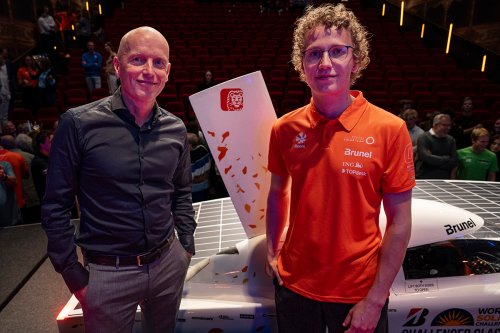Innovation to drive students outback odyssey
Innovation has always been an integral part of sport. Who could forget McLaren’s adoption of carbon fibre in helping Ayrton Senna clinch numerous Formula One victories? Or in America’s Cup yachting, Australia II’s winged keel powering them to victory over the US for the first time in 132 years.
Another sport that relies heavily on innovation and technology is the World Solar Challenge, a 3,000-kilometre solar-powered car race across Australia’s outback. Teams from all over the world, primarily made up of tertiary students, compete in this bi-annual event.
One of those is the ING-sponsored Brunel Solar Team featuring students from TU Delft in the Netherlands. While ING is a proud partner of the 18-person team, its connection doesn’t end there. ING employee Michel Zuidgeest’s son Ruben, is also the team’s race strategist.

ING’s Michel Zuidgeest and son Ruben at the launch of the Brunel Solar team’s car that will compete in the World Solar Challenge in August. Photos by Hans-Peter van Velthoven.
Ruben, 21, said the team is quietly confident of doing well in this year’s race, an ambition partly fuelled by the success of previous TU Delft teams.
“Twenty-five years ago, our team started out with the ambition of coming first, and nothing less!”
Of the 11 races they have participated in, the TU Delft team have won seven times, making them the world’s most successful solar racing team. The team has a rich history with alumni from those winning teams happy to pass on their knowledge to this year’s participants. This combined with the team’s willingness to innovate, ensures the team is optimistic of being world champion again.
Fin-tastic
One of those innovations that the team hope will give them an advantage is a fin, complete with ING logo, added to the rear of the car.
“We have done extensive testing of the fin in a wind tunnel, with very promising results. Despite having a solar panel 50 percent larger than the previous Nuna, the fin allows for lower drag under the right conditions.”
“We have even seen negative drag, meaning that the car is being pulled forward by the wind, instead of being pushed back,” explained Ruben, who is studying mechanical engineering.
Despite the team’s optimism, Ruben said there is always uncertainty in what competitors do and whether they have any tricks up their sleeve.
“We will of course be focussing mostly on driving our own best strategy, but there are definitely tactics involved. We might have to deviate from our original plan if a competitor does something unexpected. As a strategist, it is my responsibility to make such decisions on the fly.”
“Our competition is just as motivated as us, with competitors from all around the world including Twente (the Netherlands), Leuven (Belgium), Tokyo (Japan) and Michigan (US).
The wide, brown land
The Australian outback is notoriously harsh, but the team will arrive six weeks prior to the race to acclimatise, scout the race route and make the car race ready.
Despite solar cars only having a top speed of around 130-km per hour, Ruben said there were many similarities to Formula One racing.
“The race itself is a five-day long exertion of teamwork, tactics, and pit-stops in the middle of the desert. We train these extensively, so that we transition from an engineering team to a race team. I think that in that sense, solar racing can be thought of as a sport, where the best trained team has a competitive edge over others.”
Similar to today’s Formula One, safety is also of utmost importance.
“Racing is of course not without risks, especially when you are pushing the limits of technology,” said Ruben.
“In 2019, Nuna X caught fire just before the finish due to a battery fault. As a result, strict regulations are added each edition that we need to adhere to. Apart from design limitations, plenty of emphasis is put on the safety of the car and the driver, drawing similarities with the automotive industry.”
Perfect fit
Ruben’s father Michel will be waiting in anticipation at the finish line in Adelaide. Michel, who is based in Amsterdam, said ING’s partnership with the Brunel Solar Team also aligns with the team’s mission.
“We’re committed to accelerating the transition to a low-carbon economy. Supporting this team fits perfectly with our purpose and innovation approach. These students are the kind of future leaders we want to see, not just at ING, but all over the world.”

The 18-person team from TU Delft will compete in the World Solar Challenge in August.
